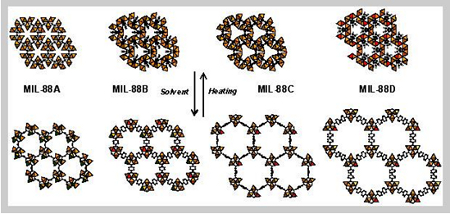Distilling Entropy from Phonons or Molecular Dynamics simulations: effect of the density of porous materials
Distilling Entropy from Phonons or Molecular Dynamics simulations: effect of the density of porous materials
Promotor(en): A. Ghysels, S. Cottenier /MM_13_MODEV06 / Solid-state physics, Model and software developmentPhysics says that a molecular system minimizes its energy at zero Kelvin, while at a finite temperature the system minimizes its free energy. The key quantity is here the entropy: how many states are available to the system given an amount of thermal energy? A direct evaluation of the entropy by counting every state is in practice intractable for high-dimensional (dimension>6) systems. For instance, when investigating a simple quartz crystal whose unit cell has 8 atoms, the dimensionality is already 27 (21 internal degrees of freedom for the atoms, 6 unit cell parameters). The entropy should then be calculated in an approximate manner, by using a smart sampling of phase space. This project aims at establishing an efficient and coherent methodology to calculate entropy of solid state materials, such that their structure may be predicted at finite temperature.
Particularly interesting is here the class of the porous flexible crystals, for instance the industrially relevant zeolite materials (e.g. used as detergent adsorbents). The entropy of these materials with pores and channels of diameter 0.5 to 2 nm is expected to differ from the entropy of common dense bcc or fcc crystals of metals. While phonons travel unhindered in perfect crystals, the pores are expected to localize phonons, with unknown repercussions on the entropy. This thesis aims at investigating the effect of pores (empty space) on the free energy.
A first method to estimate entropy is the calculation of crystal phonons and the dispersion relation, constructing the density of states, and deriving the partition function. This approach assumes that the potential energy surface is locally harmonic, which might be a poor assumption for the not so dense zeolite materials. A second method is sampling by molecular dynamics (MD) in the constant NVT ensemble by solving the Newton equations and creating molecular trajectories. MD has the advantage that anharmonicity is automatically taken into account. The question is then whether the phonon method is accurate enough despite the lacking anharmonicities, or whether full MD simulations are required.

Effect of entropy on materials with ‘holes’: how does the free energy change as a function of density? The phonon method has been implemented and is available at the Center for Molecular Modeling. Extracting the entropy from MD is still challenging: the sampling should be ergodic and sufficiently long, and entropy is only available from a series of MD trajectories. Nevertheless, recently an approximate entropy-extraction method was developed for entropy calculation from a single MD trajectory, which however should still be implemented. The goal of the project is to compare these three methods (phonon, series of MD, approximate from single MD) and to formulate guidelines which method is sufficiently accurate for which type of molecular systems.
A first step is the derivation, implementation and testing of these three methods on a toy system, e.g. consisting of one type of idealized atoms. By gradually creating a pore of increasing size, the student may investigate the effect of material density on the free energy. Open questions are, for instance: How important are the anharmonicities? Is there a specific temperature range where the approximate model works? What are the a priori conditions for the phonon spectrum to be accurate enough? Is there a quantitative measure that allows to pick out problem cases a priori, e.g. can one detect problematic materials automatically? A second step is the application on common zeolite materials, selected to represent materials with various densities. Being able to trace the free energy as function of the density, could give valuable information about the thermal stability.
- Study programmeMaster of Science in Engineering Physics [EMPHYS], Master of Science in Physics and Astronomy [CMFYST]KeywordsStatistical physics, Phonons, Molecular dynamics, Free energy calculations, Implementation, Model testingRecommended coursesComputational physics (C001827); Modeling and simulation at the nanoscale (E023370)

